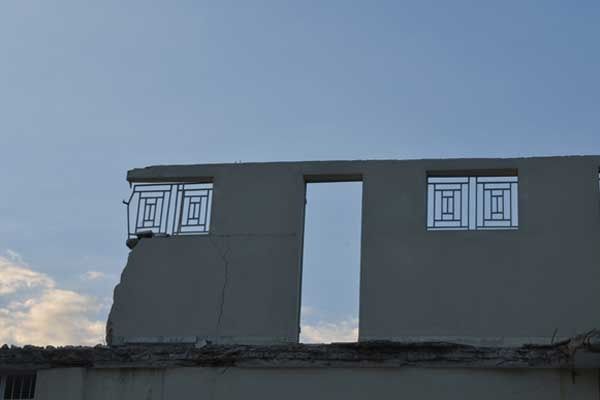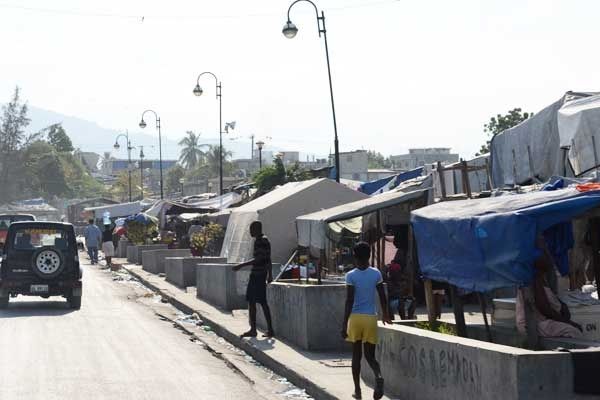Browse the extraordinary collection of images we've gathered and published over the years.
These have been compiled with the help of many fabulous people: photojournalists, international development workers, caring and observant travellers, and thousands of Verge readers, who have contributed their images and stories.
Sit down, grab a cup of your favourite brew, kick back and browse through the galleries. If you are inspired, please share with your friends—or contribute your own images and stories in our next photo contest.
P.S. If you happen to be organizing an event and are in need of a little visual flair, many of these exhibits are available for loan. Please contact us for details.
January 2011
Nearly a year after the massive earthquake in Haiti, challenges for the reconstruction effort continue. James Stairs checks in with the Canadian Red Cross in Jacmel.
Produced with the support of the Government of Canada through the Canadian International Development Agency.
Nearly a year after the massive earthquake in Haiti, challenges for the reconstruction effort continue. James Stairs checks in with the Canadian Red Cross in Jacmel.
photo: Sophie Chavanel / Canadian Red Cross

One year after the massive earthquake, huge piles of rubble from collapsed buildings remain everywhere. United Nations officials estimate that there are 19 million cubic metres of rubble in Haiti.
photographer: James Stairs

Collapsed houses and makeshift camps mark the landscape, as does the omnipresent rubble. Many of the buildings still standing are too dangerous to inhabit.
photographer: James Stairs

In Leogane, the closest urban centre to the heart of January's earthquake, as many as 90 per cent of the town's structures were heavily damaged, according to UN estimates.
photographer: James Stairs

Tents line the median of the highway out of the capital, Port-au-Prince. Four chaotic lanes of traffic roar by the makeshift island homes in two directions. Large trucks, passing inches from the tents occasionally blow the flaps open to reveal entire families with tiny children crouching inside.
photographer: James Stairs

It is this landscape that Canadian Red Cross worker Erin Grinnell and her Haitian outreach team have been working in for the past seven months.
photographer: James Stairs

Grinnell, 37, (right) is the Community Mobilisation Delegate for the Canadian Red Cross shelter program based in Jacmel. Her job is to oversee a team of workers selecting people to move from tents to specially designed houses provided by the Canadian Red Cross.
photographer: James Stairs

In the effort to build new homes for Haiti’s estimated 1.5 million survivors, aid agencies must determine who owns each piece of land before they can even begin work.
In a country where millions of people lost everything, land deeds are a rarity. For those who own land, proving it has become problematic; according to the United Nations, less than 5 per cent of Haiti’s land is now officially accounted for in public records.
photographer: Sophie Chavanel / Canadian Red Cross

The small houses, assembled with new plywood, a wood frame and a tin roof, stand out in the informal camps that dot the region. They have been specially designed for Haiti’s conditions, and can be easily relocated in the event of a land dispute or another emergency.
photographer: Sophie Chavanel / Canadian Red Cross

Rosana Cenatis, standing in front of the newly finished house in Jacmel. Like her neighbours, Cenatis fled when the small concrete house she and her family lived in collapsed. Until recently, she lived in the tent city nearby.
“I had nowhere to go,” she says. “Living in a tent is not an easy life.”
photographer: Sophie Chavanel / Canadian Red Cross

“So many people here have had such bad luck and have been living under really hard conditions but they still laugh,” according to Grinnell. “You can really see them picking up their lives.”
photographer: Sophie Chavanel / Canadian Red Cross

The challenge is to move things forward as quickly as possible and get people in to new shelters as soon as they can. According to Grinnell, the team is feeling the pressure, and not just because the local needs are so great. “The world is watching. There are a lot of expectations.”
photographer: James Stairs

Nearly a year after the massive earthquake in Haiti, challenges for the reconstruction effort continue. James Stairs checks in with the Canadian Red Cross in Jacmel.
photo: Sophie Chavanel / Canadian Red Cross
One year after the massive earthquake, huge piles of rubble from collapsed buildings remain everywhere. United Nations officials estimate that there are 19 million cubic metres of rubble in Haiti.
photographer: James Stairs
Collapsed houses and makeshift camps mark the landscape, as does the omnipresent rubble. Many of the buildings still standing are too dangerous to inhabit.
photographer: James Stairs
In Leogane, the closest urban centre to the heart of January's earthquake, as many as 90 per cent of the town's structures were heavily damaged, according to UN estimates.
photographer: James Stairs
Tents line the median of the highway out of the capital, Port-au-Prince. Four chaotic lanes of traffic roar by the makeshift island homes in two directions. Large trucks, passing inches from the tents occasionally blow the flaps open to reveal entire families with tiny children crouching inside.
photographer: James Stairs
It is this landscape that Canadian Red Cross worker Erin Grinnell and her Haitian outreach team have been working in for the past seven months.
photographer: James Stairs
Grinnell, 37, (right) is the Community Mobilisation Delegate for the Canadian Red Cross shelter program based in Jacmel. Her job is to oversee a team of workers selecting people to move from tents to specially designed houses provided by the Canadian Red Cross.
photographer: James Stairs
In the effort to build new homes for Haiti’s estimated 1.5 million survivors, aid agencies must determine who owns each piece of land before they can even begin work.
In a country where millions of people lost everything, land deeds are a rarity. For those who own land, proving it has become problematic; according to the United Nations, less than 5 per cent of Haiti’s land is now officially accounted for in public records.
photographer: Sophie Chavanel / Canadian Red Cross
The small houses, assembled with new plywood, a wood frame and a tin roof, stand out in the informal camps that dot the region. They have been specially designed for Haiti’s conditions, and can be easily relocated in the event of a land dispute or another emergency.
photographer: Sophie Chavanel / Canadian Red Cross
Rosana Cenatis, standing in front of the newly finished house in Jacmel. Like her neighbours, Cenatis fled when the small concrete house she and her family lived in collapsed. Until recently, she lived in the tent city nearby.
“I had nowhere to go,” she says. “Living in a tent is not an easy life.”
photographer: Sophie Chavanel / Canadian Red Cross
“So many people here have had such bad luck and have been living under really hard conditions but they still laugh,” according to Grinnell. “You can really see them picking up their lives.”
photographer: Sophie Chavanel / Canadian Red Cross
The challenge is to move things forward as quickly as possible and get people in to new shelters as soon as they can. According to Grinnell, the team is feeling the pressure, and not just because the local needs are so great. “The world is watching. There are a lot of expectations.”
photographer: James Stairs
Travel with purpose; travel for good. Articles, resources and events for ethical and meaningful travel, volunteering, working and studying abroad.
Verge believes in travel for change. International experience creates global citizens, who can change our planet for the better. This belief is at the core of everything we do.

